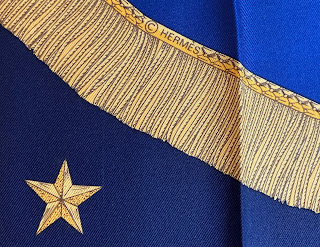Hermès Scarf - Poste et Cavalerie -
Designed by Joachim Metz in 1987.
The artist's signature, "J. Metz" (Joachim Metz) is in the fringe on one corner.
The copyright is in the braid on another corner.
Designed by Joachim Metz in 1987.
These panels are examples of cavalry "sabertache".
A sabretache is a flat, leather pouch or satchel with long straps traditionally worn by some cavalry and horse artillery officers from the left-hand side of the waist belt near to the officer's saber. "Tasche" can be translated as "pocket" or "bag" or "case" in German.
There is a central image - epaulet?
Since it looks like the blue center is surrounded by fringe, it is not likely to be a bag front.
But maybe those are not supposed to be fringe but rather embroidered gold threads.
Around the center are eight bag fronts.
The center bottom is the only one in the gray color.
Beneath it is the HERMÈS - PARIS.
There are three in green.
They alternate with a red ones. The red ones are all identical.
The artist's signature, "J. Metz" (Joachim Metz) is in the fringe on one corner.
The copyright is in the braid on another corner.
Like all Hermès scarves, this drapes beautifully and gives lots of options to wear.
You can choose which color to display by how you arrange the scarf.
You can choose which color to display by how you arrange the scarf.
“Poste et Cavalerie” by Joachim Metz was originally issued in 1987. The early issues missed the accent on Hermès and the font was quite shaky. Subsequent re-issues corrected these problems. There are several vintage FAKE versions that appear from time to time on Ebay. The Italian version with the “Hermès Paris” and caleche logo printed in the corner is easy to spot.
There are eight sabretaches in this design. Four alternate ones are the same. Those at 12, 3, 6 and 9 o’clock show different emblems, the one at 3 o’clock having the number 4 very obviously featured. This is a sabretache from the French 4th Regiment of Hussars.
Many of the fakes are missing the title which should be just inside the inner circle towards the centre. If there is no title then it is a FAKE.
Missing these indicators make the scarf a FAKE. But remember the newer FAKES that seem to be photo accurate and copy all the right indicators including the copyright marks. Having all these right DOES NOT MAKE THEM GENUINE!
Historical note:
The sabretache is derived from a traditional Hungarian horseman’s flat leather bag called a tarsoly. Early examples have been found the tombs of Magyar warriors from the 10th century Conquest of Pannonia. They were often strengthened and decorated with silver plates and would have contained fire-making tools and other essentials.
Hussar Cavalry became popular amongst the European Powers in the early 18th century and a tarsoly was often a part of the accoutrements. The German name sabretache was adopted, tache meaning "pocket". It fulfilled the function of a pocket, which were absent from the tight fitting uniform of the Hussar style. Part of the wartime function of the light cavalry was to deliver orders and dispatches.... and the sabertache was well suited to hold these.














No comments:
Post a Comment